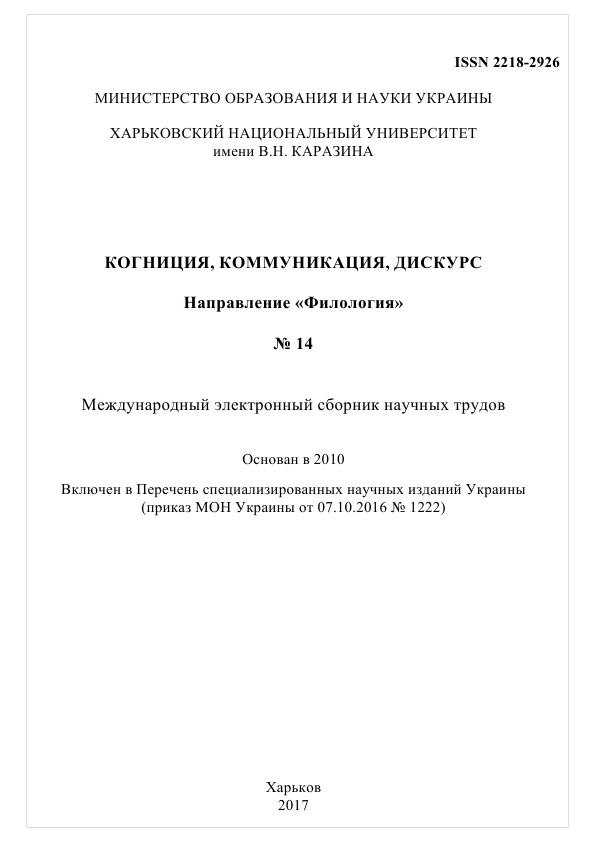Імплікатури поетичного тексту в аспекті перекладу
Анотація
Закономірності відтворення імплікатур при перекладі поетичних текстів розглядаються на матеріалі перекладів мініатюр Маші Калеко та Роберта Ґернгардта Г. Ейгером. Головною рисою імплікатури є те, що вона навмисно вкладається автором у висловлення. Створюючи поетичний текст, автор має два різновиди інтенції: 1) референтивну, яка пов’язана із референцією – співвіднесенням слів зі станами речей зовнішнього світу, та 2) естетичну – позитивне емоційно-оцінне ставлення до створюваної вербальної форми. Імплікатури поетичного тексту відображають і референтивну, і естетичну інтенцію. Вони одночасно реферують і до станів речей зовнішнього світу (власне референція), і до слів (авто-референція). Тому їх відтворення у перекладі має подвійне значення – як для передачі змісту тексту, так і для відображення ідіостилю автора. Кожна імплікатура належить одному з двох рівнів комунікації, які виокремлюються у художньому тексті: а) вертикальному – комунікація між автором і читачем, б) горизонтальному – комунікація між персонажами тексту. Встановлено два випадки відтворення імплікатур вихідного тексту – збереження і втрата. У першому випадку наявні три можливості: 1) перекладачу вдається відтворити імплікатуру такими ж засобами, як її виражено
в оригіналі; 2) оригінальне висловлення, що породжує імплікатуру, відрізняється граматично
від тексту перекладу; 3) перекладач мусить використовувати інші мовні засоби для відтворення імплікатури. В другому випадку наявні три можливості: 1) експлікація імплікатури, 2) заміна її
на іншу імплікатуру, 3) повна втрата.
Завантаження
Посилання
Безугла Л.Р. Вербалізація імпліцитних смислів у німецькомовному діалогічному дискурсі / Л.Р. Безугла. – Харків : ХНУ ім. В.Н. Каразіна, 2007. – 332 с.
Безугла Л.Р. Дидактичні аспекти теорії імплікатур / Л.Р. Безугла // Сучасні фундаментальні теорії та інноваційні практики навчання іноземної мови у вузі. – Х. : ХНУ ім. В.Н. Каразіна, 2013а. – С. 114–138.
Безуглая Л.Р. Прагмапоэтика в когнитивном измерении // Вісник Київ. нац. лінгв. ун-ту. Серія «Філологія». – 2013b. – Т. 16, № 2. – С. 20–27.
Кашичкин А.В. Имплицитность в контексте перевода : автореф. дис. … канд. филол. наук : спец. 10.02.20 / А.В. Кашичкин ; МГЛУ. – М., 2003. – 26 с.
Нефедова Л.А. Когнитивно-типологический аспект импликативной коммуникации
(на материале французских текстов и их переводов на русский язык) : автореф. дис. ... доктора филол. наук : 10.02.20 / Л.А. Нефедова ; УГПУ. – Екатеринбург, 2001. – 41 с.
Почепцов Г.Г. Избранные труды по лингвистике / Г.Г. Почепцов. – Харьков : ХНУ
им. В.Н. Каразина, 2009. – 556 с.
Эткинд Е.Г. Разговор о стихах / Е.Г. Эткинд. – СПб. : ДЕТГИЗ, 2004. – 240 с.
Якобсон Р.О. Лингвистика и поэтика / Р.О. Якобсон // Структурализм: «за» и «против». – М. : Прогресс, 1975. – С. 193–230.
Bouton L.F. Conversational Implicature in a second Language: Learned Slowly when not Deliberately Taught / L.F. Bouton // Journal of Pragmatics. – 1994. – Vol. 22. – P. 157–167.
Grice H.P. Studies in the Way of Word / H.P. Grice. – Cambridge (Mass.), L. : Harvard Univ. Press, 1991. – 406 p.
Harras G. Jenseits von semantischen Konventionen – zum Beispiel: tautologische Äußerungen / G. Harras // Zeitschrift für germanistische Linguistik. – 1999. – Heft 27. – S. 1–12.
Heringer H.J. Gricesche Maximen und interkulturelle Kommunikation / H.J. Heringer // Sprache und Literatur in Wissenschaft und Unterricht. – 1994. – Heft 25. – 2. Halbjahr. –
S. 40–49.
Levinson S.C. Pragmatik / S.C. Levinson ; ins Dt. üb. von M. Wiese. – Tübingen : Niemeyer, 2001. – 476 S.
Meibauer J. Pragmatik / J. Meibauer. – Tübingen : Stauffenburg, 2001. – 208 S.
Автори, які публікуються у цьому журналі, погоджуються з наступними умовами:
Автори залишають за собою право на авторство своєї роботи та передають журналу право першої публікації цієї роботи на умовах ліцензії Creative Commons Attribution License (CC BY), яка дозволяє іншим особам вільно розповсюджувати опубліковану роботу з обов'язковим посиланням на авторів оригінальної роботи та першу публікацію роботи у цьому журналі.
Автори мають право укладати самостійні додаткові угоди щодо неексклюзивного розповсюдження роботи у тому вигляді, в якому вона була опублікована цим журналом (наприклад, розміщувати роботу в електронному сховищі установи або публікувати у складі монографії), за умови збереження посилання на першу публікацію роботи у цьому журналі.
Політика журналу дозволяє і заохочує розміщення авторами в мережі Інтернет (наприклад, у сховищах установ або на особистих веб-сайтах) рукопису роботи, як до подання цього рукопису до редакції, так і під час його редакційного опрацювання, оскільки це сприяє виникненню продуктивної наукової дискусії та позитивно позначається на оперативності та динаміці цитування опублікованої роботи (див. The Effect of Open Access).




